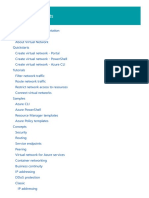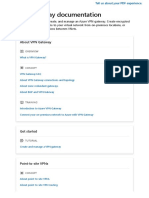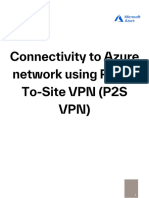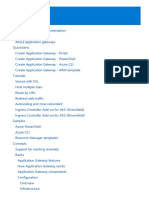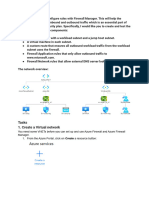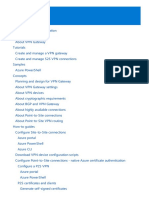0 ratings0% found this document useful (0 votes) 94 views16 pagesCreate A Gateway Load Balancer Using The Azure Portal
Copyright
© © All Rights Reserved
We take content rights seriously. If you suspect this is your content,
claim it here.
Available Formats
Download as PDF or read online on Scribd
125124, 752 PM “Tutorial: Create a gateway load balancer - Azure portal - Azure Load Balancer | Microsoft Learn
Tutorial: Create a gateway load balancer
using the Azure portal
Article + 11/01/2023
Azure Load Balancer consists of Standard, Basic, and Gateway SKUs. Gateway Load Balancer
is used for transparent insertion of Network Virtual Appliances (NVA). Use Gateway Load
Balancer for scenarios that require high performance and high scalability of NVAs.
In this tutorial, you learn how to:
VY Create virtual network
Y Create network security group.
V Create a gateway load balancer.
VY Chain a load balancer frontend to gateway load balancer.
Prerequisites
* An Azure account with an active subscription. Create an account for free
* An existing public standard SKU Azure Load Balancer. For more information on
creating a load balancer, see Create a public load balancer using the Azure portal
© For the purposes of this tutorial, the load balancer in the examples is named load
balancer.
* A virtual machine or network virtual appliance for testing,
Sign in to Azure
Sign in to the Azure portal
Create a virtual network and bastion host
The following procedure creates a virtual network with a resource subnet, an Azure Bastion
subnet, and an Azure Bastion host.
© Important
ntips:leam microsot.comlen-us/azureload-balancorfutora-gateway-portal a6�‘vasa, 7.52 Pm “Tutor Create a gatowsy load balancer Azure portal - Are Load Balancer | Microsoft Leam
Hourly pricing starts from the moment that Bastion is deployed, regardless of
outbound data usage. For more information, see Pricing and SKUs.
If you're deploying Bastion as part of a tutorial or test, we recommend that you delete
this resource after you finish using it.
1. In the portal, search for and select Virtual networks.
2. On the Virtual networks page, select + Create.
3. On the Basics tab of Create
tual network, enter or select the following information:
© Expand table
Setting Value
Project details
Subscription Select your subscription.
Resource group Select Create new.
Enter load-balancer-rg in Name.
Select OK.
Instance details
Name Enter Ib-vnet
Region Select East US.
nttps:lleam microsot.comlen-us/azureload-balancorfutora-gateway-portal 26�“125124, 7:52 PM
gateway load balancer - Azure portal -Azu
Load Balancer | Microsoft Learn
re
t
a
«
°
©
&
Home > Vinual networks
Create virtual network x
Basics Secunty Padkhesser Tage Review +ceate
Asie Vital Net (ie the fundamental buleing Rack fr you pte networkin Azur Neen may pst of
‘aur esoutces, such 35 ze Virtual Machies (M1 Securely Communit wth exh ote, tb erat ahd on-premises
rensvts avis rare # radon natn ta os open your ou ots arta bengswth sons
tenets oF Azure'sinanictie seh as sc asi and oer
Project deta
Sele the sabeciption to mange dpe escctes an cos Ut resource goup ie rete orgie ane manage all
sutrpton ae ¥
l .
rescue group (Ne oa ce ¥
‘Vetus network nme lbamet
region © * eeus ~
4, Select the Security tab or Next button at the bottom of the page.
5. Under Azure Bastion, enter or select the following information:
<2 Expand table
Setting Value
Azure Bastion
Enable Azure Bastion Select checkbox
Azure Bastion host name Enter Ib-bastion.
‘Azure Bastion public IP address Select Create new.
Enter Ib-bastion-ip in Name.
hntps:ilear microsoft. conver-usiazureload-Dalanceritutoial-gateway-pertal 36�125124, 752 PM “Tutorial: Create a gateway load balancer - Azure portal - Azure Load Balancer | Microsoft Learn
Setting
Value
Select OK.
6, Select the IP addresses tab, or Next at the bottom of the page.
7. On Create virtual network page, enter or select the following information:
Setting
‘Add IPv4 address space
IPv4 address space
Subnets
Subnet template
Name
Starting address
Subnet size
Security
NAT Gateway
2 Expand table
Value
Enter 10.0.0.0/16 (65,356 addresses)
Select the default subnet link to edit.
Leave the default Default
Enter backend-subnet.
Enter 10.0.0.0.
Enter /24(256 addresses),
Select Ib-nat-gateway.
nttps:lleam microsot.comlen-us/azureload-balancorfutora-gateway-portal
ane�“125124, 7:52 PM Tutorial:
Edit subnet
1 gateway load balancer -Azure portal -Azure Load Balancer | Microsoft Learn
x
Select an address space and configure your subnet, You can customize a defeult subnet or
select from subnet templates if you plan to add select services later. Learn more c
IP address space @
Subnet details
Subnat template ©
Name~@
Starting address * ©
Subnet size @
IP address space @
‘Security
0.0.0.0/16
10.0.0.0- 10.0.255.255 (65536 addresses)
Default v
backend-subnet ]
(Fone
7/24 (256 addresses) v|
10.0.0 - 100.0255 (256 addresses)
Simplify internet access for virtual machines by using a network address translation gateway.
Filter subnet traffic using 2 network security group. Learn more ©?
NAT gateway ©
Network security group ©
Route table
8, Select Save.
None v
Create new
None v
Create new
None v
9. Select Review + create at the bottom of the screen, and when validation passes,
select Create.
hntps:lear microsoft. conver-usiazureload-Dalancertuteial-gateway-pertal
516�125124, 752 PM “Tutorial: Create a gateway load balancer - Azure portal - Azure Load Balancer | Microsoft Learn
Create NSG
Use the following example to create a network security group. You configure the NSG rules
needed for network traffic in the virtual network created previously.
1. In the search box at the top of the portal, enter Network Security. Select Network
security groups in the search results.
2. Select + Create.
3. In the Basics tab of Create network security group, enter, or select the following
information:
© Expand table
Setting Value
Project details
Subscription Select your subscription,
Resource group Select load-balancer-rg
Instance details
Name Enter *b-nsg-R
Region Select East US.
4, Select the Review + create tab or select the Review + create button
5. Select Create.
6. In the search box at the top of the portal, enter Network Security. Select Network
security groups in the search results.
7. Select *lb-nsg-R.
8, Select Inbound security rules in Settings in *lb-nsg-R.
9, Select + Add.
10. In Add inbound security rule, enter or select the following information
ntips:leam microsot.comlen-us/azureload-balancorfutora-gateway-portal ene�125124, 752 PM “Tutorial: Create a gateway load balancer - Azure portal - Azure Load Balancer | Microsoft Learn
Setting
Source
Source port ranges
Destination
Service
Destination port ranges
Protocol
Action
Priority
Name
11, Select Add,
12. Select Outbound security rules in Set
13, Select + Add.
(2 Expand table
Value
Leave the default of Any.
Leave the default of
Leave the default of Any.
Leave the default of Custom,
Enter
Select Any.
Leave the default of Allow.
Enter 100.
Enter Ilb-nsg-Rule-AllowAll-All
14. In Add outbound security rule, enter or select the following information.
Setting
Source
Source port ranges
Destination
Service
Destination port ranges
Protocol
Action
2 Expand table
Value
Leave the default of Any.
Leave the default of *.
Leave the default of Any.
Leave the default of Custom.
Enter".
Select TCP.
Leave the default of Allow.
nttps:lleam microsot.comlen-us/azureload-balancorfutora-gateway-portal 76�125124, 752 PM “Tutorial: Create a gateway load balancer - Azure portal - Azure Load Balancer | Microsoft Learn
Setting Value
Priority Enter 100.
Name Enter Ib-nsg-Rule-AllowAll-TCP-Out
15, Select Add.
Select this NSG when creating the NVAs for your deployment.
Create Gateway Load Balancer
In this section, you create the configuration and deploy the gateway load balancer.
1. In the search box at the top of the portal, enter Load balancer. Select Load balancers
in the search results.
2. In the Load balancer page, select Create.
3. In the Basics tab of the Create load balancer page, enter, or select the following
information:
©) Expand table
Setting Value
Project details
Subscription Select your subscription.
Resource group Select load-balancer-rg
Instance details
Name Enter gateway-load-balancer
Region Select (US) East US.
Type Select Internal.
sku Select Gateway.
nttps:lleam microsot.comlen-us/azureload-balancorfutora-gateway-portal ane�“125124, 7:52 PM Tutorial:
gateway load balancer - Azure portal -Azu
Lead Balancer | Microsoft
Home > Resource groups > laad-balancerg > Marketplace > Load Balancar >
Create load balancer a
asics 7 : " , t
‘Azure oad balancer slayer oad bance that stnbutesinceming vac among heathy vital machine instances. Lad
belncers uses a hash-hasea distri algorithm 8y cfu uses a Stuplescure I, source por, cesiratin I,
Castnaticn pow. pretool ype) hezh fo map trafic to salvia savers Load balancer can athe be internet ‘song where it
faccesablewa pubic addresses. or internal where tony accesible fom 3 wtual network Azure load balancer ao suppert
‘Network dates: Tandtion NA to toute vac bettcen public and pat P adresses. Laan more
rt si
Le pease =a =
one ti
ma = 7
ae Osim
O Basie
wero
Tier * @® Regional
| [ents | ea emer conigmaion>—] ooolond atelier automation
eve eeack
4, Select Next: Frontend IP configuration at the bottom of the page.
5. In Frontend IP configuration, select + Add a frontend IP.
6. In Add frontend IP configuration, enter or select the following information:
© Expand table
Setting Value
Name Enter Ib-frontend-IP.
Virtual network Select Ib-vnet.
hntps:lear microsoft. conver-usiazureload-Dalancertuteial-gateway-pertal one�125124, 752 PM “Tutorial: Create a gateway load balancer - Azure portal - Azure Load Balancer | Microsoft Learn
Setting Value
Subnet Select backend-subnet.
Assignment Select Dynamic
7. Select Add.
8, Select Next: Backend pools at the bottom of the page.
9, In the Backend pools tab, select + Add a backend pool.
10. In Add backend pool, enter or select the following information.
2 Expand table
Setting Value
Name Enter Ib-backend-pool.
Backend Pool Configuration Select NIC.
IP Version Select IPv4.
Gateway load balancer configuration
Type Select Internal and External
Internal port Leave the default of 10800.
Internal identifier Leave the default of 800.
External port Leave the default of 10801
External identifier Leave the default of 801
11. Select Add.
12, Select the Next: Inbound rules button at the bottom of the page.
13. In Load balancing rule in the Inbound rules tab, select + Add a load balancing rule.
14, In Add load balancing rule, enter or select the following information:
(© Expand table
nttps:lleam microsot.comlen-us/azureload-balancorfutora-gateway-portal 1016�125124, 752 PM
“Tutorial: Create a gateway load balancer - Azure portal - Azure Load Balancer | Microsoft Learn
Setting
Name
IP Version
Frontend IP address
Backend pool
Health probe
Session persistence
Enable TCP reset
Enable floating IP
Value
Enter Ib-rule
Select IPv4 or IPV6 depending on your requirements.
Select Ib-frontend-IP.
Select Ib-backend-pool.
Select Create new.
In Name, enter Ib-health-probe
Select TCP in Protocol.
Leave the rest of the defaults, and select Save.
Select None.
Leave the default of unchecked
Leave default of unchecked.
nttps:lleam microsot.comlen-us/azureload-balancorfutora-gateway-portal
16�“125124, 7:52 PM Tutorial:
a gstowsy load balancer Azure pol - Aire Load Balancer | Microsoft Lear
Add load balancing rule x
gateway-load-balancer
A lead balancing rule distributes incoming treffic that is sent to a selected IP address and port
combination across a group of backend pool instances. Only backend instances that the health
probe considers healthy receive new traffic,
Name* [Ib-rule
1p Version ~ © wa
O we
Frontend IP address * [Ib-frontendt-ip (Dynamic) v
Backend pool * @ [Ibackend-poot
High availabilty ports @ Enabled
Health probe [ Ie-health-probe crcP:80) ¥]
eate new
Sestion persistence @) [None SS—S—™—SSS J
Idle timeout (minutes) ~ © 4
Enable TCP Reset
Enable Floating IP. ©
[[eancet_] Give feedback
15, Select Save.
16, Select the blue Review + create button at the bottom of the page.
17. Select Create.
Add network virtual appliances to the gateway
load balancer backend pool
Deploy NVAs through the Azure Marketplace. Once deployed, add the NVA virtual
machines to the backend pool of the gateway load balancer. To add the virtual machines,
go to the backend pools tab of your gateway load balancer.
hntps:lear microsoft. conver-usiazureload-Dalancertuteial-gateway-pertal rane�125124, 752 PM “Tutorial: Create a gateway load balancer - Azure portal - Azure Load Balancer | Microsoft Learn
Chain load balancer frontend to the gateway
load balancer
In this example, you'll chain the frontend of a standard load balancer to the gateway load
balancer.
You add the frontend to the frontend IP of an existing load balancer in your subscription.
1. In the search box in the Azure portal, enter Load balancer. In the search results, select
Load balancers.
2. In Load balancers, select load-balancer or your existing load balancer name.
3. In the load balancer page, select Frontend IP configuration in Settings.
4, Select the frontend IP of the load balancer. In this example, the name of the frontend
is Ib-frontend-IP.
fy load-balancer | Frontend IP configuration x
eve festa
© overew
BE Actty tog l —e J
Name 7s addrass 7 Rules count Te
Access contra TAM]
frontend Ue-rontendl_0 a
© tags *
X iagnose and solve problems
Settings
1 tend pen
I nb na
i ope
@ tod
5. Select Ib-frontend-IP (10.1.0.4) in the pull-down box next to Gateway load balancer.
6. Select Save.
nttps:lleam microsot.comlen-us/azureload-balancorfutora-gateway-portal 1916�125124, 752 PM “Tutorial: Create a gateway load balancer - Azure portal - Azure Load Balancer | Microsoft Learn
Ib-frontend-ip x
5 Public
‘ype
ype © wasves O pete
publi ares * Teoria ¥
Grete new
Gateway Lad balancer Tbrrontend W000 a
Mo 224- 578-2 BASTE Reso cep ad
Used by
Telit elaad balancing rule, inbound NAT rls, inbound NAT peck, and eutbeund rules using this addres
Name Tye
“Give feedback
Chain virtual machine to Gateway Load Balancer
Alternatively, you can chain a VM's NIC IP configuration to the gateway load balancer.
You add the gateway load balancer's frontend to an existing VM's NIC IP configuration.
© Important
A virtual machine must have a public IP address assigned before attempting to chain
the NIC configuration to the frontend of the gateway load balancer.
1. In the search box in the Azure portal, enter Virtual machine. In the search results,
select Virtual machines.
2. In Virtual machines, select the virtual machine that you want to add to the gateway
load balancer. In this example, the virtual machine is named myVM1
3. In the overview of the virtual machine, select Networking in Settings.
4, In Networking, select the name of the network interface attached to the virtual
machine. In this example, it's myvn1229.
ntips:leam microsot.comlen-us/azureload-balancorfutora-gateway-portal sane�“125124, 7:52 PM Tutorial: C
| MYM | Networking
B tnties
om
5. In the network interface page, select IP configurations in Settings.
6, Select Ib-frontend-IP in Gateway Load balancer.
sl Myvm229 | IP configurations
7. Select Save.
Clean up resources
When no longer needed, delete the resource group, load balancer, and all related
1 gateway load balancer -Azure portal -Azure Load Balancer | MicrosoftLearn
resources, To do so, select the resource group load-balancer-rg that contains the resources
and then select Delete.
Next steps
Create Network Virtual Appliances in Azure
When creating the NVAs, choose the resources created in this tutorial:
* Virtual network
hntps:lear microsoft. conver-usiazureload-Dalancertuteial-gateway-pertal
site�gateway load balancer - Azure portal - Azure Load Balancer | Microsoft Lear
125124, 752 PM Tutorial:
Subnet
‘* Network security group
© Gateway load balancer
Advance to the next article to learn how to create a cross-region Azure Load Balancer.
nttps:lleam microsot.comlen-us/azureload-balancorfutora-gateway-portal 1616



































